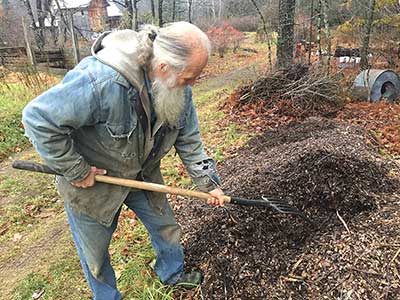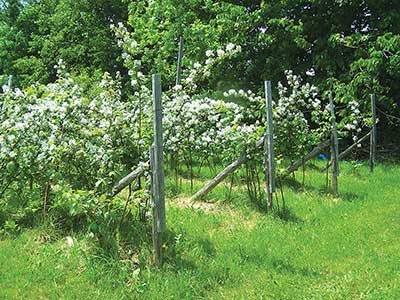 |
| A pile of year-old chips partially transformed by white mold. |
 |
| These heavily-bearing blackberry plants have never been treated with anything but chip mulch. |
By Will Bonsall
I’ve spoken and written extensively about using forest residues, especially shredded brushwood, or “ramial chips,” to build and maintain soil tilth. I’ve advocated incorporating them into gardens as short-term mulch or into compost after they’ve been partially decayed by white molds. One can use enormous amounts of woody residues this way, but would-be chip users voice two concerns: Chips obtained from roadside chipping crews can be too coarse for direct use, and the resins in chips from conifers – pine, spruce, hemlock, etc. – break down slowly and can acidify soil.
Regarding the first concern, I have a chipper/shredder that can quickly re-chip these piles, but not everyone has one. I can also use coarser and even resinous chips on several crops without harm; in fact some crops almost seem to prefer them. I’m not talking about cultivated crops that require a finer, mellower soil, but permacrops – mostly shrubs and trees – that don’t require cultivation and prefer a permanent mulch of moldy woody debris. Several acid-loving berries do fine with such rubbish. Raspberries, for example: We most often find wild patches growing luxuriantly with no added inputs in logging clearcuts, places where the ground is thickly littered with coniferous slash. The awkwardly sized slash is slow to lie down and decay properly, yet cane fruits delight in living among that stuff, as do blackberries, black raspberries, boysenberries, dewberries, currants, gooseberries and blueberries. Hardy kiwis are also comfortable in acidic woody debris; in fact in their natural Asian habitat, they typically grow on dead pine snags.
Maybe you’re thinking, “Sure, how nice for a mulch, but what about fertility?” That’s always a vital concern with our garden vegetable crops, so why not with permacrops? For one thing, garden crops are mostly derived from ecological “Band-Aid” species: plants whose ecological role is to quickly germinate and cover disturbed soil until a more sustainable plant community can succeed them. They need the right conditions immediately or they’ll fail. In contrast, woody, shrubby permacrops are, as the word implies, in it for the long haul. Aside from their fruit, they produce relatively large amounts of soil-building material with little input, given several years in one place. Their roots are more expansive and aggressive (“weedier”); and partly due to their long-term fungal associations, they can dissolve and assimilate minerals that are inaccessible to the Band-Aid crop species.
What about nitrogen (N)? All plants use N for growth, and woody residues are woefully deficient in that vital element. However, not all plant species need to be spoon-fed N; some have a remarkable ability to scrounge it. For example, leguminous plants get atmospheric N from rhizobia nodules that “infect” their rootlets, but what about permacrops? Their fungal associations, especially white molds, promote the breakdown of cellulose (the main component of wood, but lacking in N) and in turn are consumed by a microbial community. In the midst of that living and dying, plenty of N shows up. “Build it and they will come.” Think about it: turning an armful of pine branches into a basketful of berries is about as magical as it gets.
As mysterious as is this conversion of woody debris into humus, another principle is at work that I call the “cover-the-earth” effect. This phenomenon, elucidated by Caleb Harlan in the 1880s and in his book “Farming with green manures on Plumgrove Farm,” observes that when any soil is covered by any material, regardless of its inherent nutrient content, for an extended time (weeks or months anyway), the richness of that soil increases out of proportion to the fertilizing value of the covering material. Combined with microbial activity, this suggests how we may parlay something of supposedly little value (woody waste) into something of considerable value (fruit); in other words, to spin straw into gold.
What keeps these coarse, woody, often resinous materials from becoming a liability is how they are applied. Unlike with vegetables, we never incorporate them into the soil directly but simply apply them on top of the soil and leave them there. This minimizes the anaerobic activity that impedes decay, and it avoids damaging the existing soil community by not disturbing the soil. Also, placing woody residues on the surface makes the fragment size less important. Large chunks of wood, branch segments and slabs of bark are no problem, provided new canes or shoots can poke through them. In fact, by repressing grass and other weeds, there is less competition for water and nutrients.
This aerobic surface application is especially important for resinous residues, as these resins can produce decay-resistant polyphenols when buried deeper in the soil. While the berry crops mentioned so far are comfortable with coniferous mulches, some other permacrops may tolerate coniferous residues but will be much happier with hardwood materials. Hazelnuts, apples and most other orchard fruits can benefit from chips of deciduous trees, both in repressing competing grasses and from the cover-the-earth effect. These also include grapes, hip roses, quince and medlars, all of which I prefer to mulch with hardwood chips; if I do use much coniferous mulch on them, I spread some wood ash on top of it to neutralize excess acid.
Woody mulches kill established sod, turning it from a source of competition into an in situ compost. As valuable as it is to the soil, though, that sod-based humus is relatively short-lived and will be largely burned out within a few years, whereas the woody stuff will form a much more durable energy substrate for crop plants and their microbial cohorts.
Can chips be applied too heavily? I assume so. I always say excess is fine if done in moderation. For one thing, roots need to breathe while digging into the soil for minerals. Several inches of woody mulch added all at once would have a smothering effect. Most of these permacrops, like the cane-fruits, need to send up new shoots every year to replace the dead, old fruiting canes, and there are limits to how much they can penetrate. For example, my wife dumped all of our woodyard waste – sawdust, bark, small chunks – directly onto our blackberry row for years, insisting that the young shoots would “find a way” to the surface. They did, but not through the deepest mulch. Rather, they spread sideways, pushing up through the thinner edges. The problem? The center of the row died, while two new rows formed on either side, creating a much wider bed than I wanted. I’ve been correcting the problem since then by leaving the mulch a bit thinner in the actual row while piling it deeper on either side to encourage new growth in the center.
That blackberry patch is also a good example of how much woody rubbish can contribute to soil fertility indirectly. When I started the patch, I did not prep the area, which was covered by a sod of variable thickness and vigor. I did not till the soil, nor did I add a spoonful of compost, lime or wood ash. I didn’t even dig proper holes for the plants. I merely cut slits in the sod with a spade about 2 feet apart and crammed in the young roots. I didn’t even water. I did dump some woodyard waste, including a lot of softwood building debris, in a wide band on either side of the row – not enough to help much; just what I had on hand. In some areas the mulch merely killed the sod; in others the grass grew even more vigorously among the mulch (which was spread unevenly). Witchgrass and orchardgrass tended to predominate, as they thrive in that situation. The blackberry plants grew modestly that year. The second year a new batch of shoots outgrew the first year’s, reaching 2 or 3 feet high and producing few berries. Every year we added more hardwood and softwood mulch, and every year the new canes grew taller than the former year’s fruiting canes. Berry yields increased proportionately. At 8 to 10 feet, the canes continued to proliferate, still with no material added other than woodyard waste. The unmulched aisles between rows are mostly grass, and when mown the rotary mower blows most of the clippings into the row, adding a bit of N-rich material. However, that is merely the product of the overall patch, since we’ve never added anything to enrich the aisles either.
I presume that some other permacrops would benefit from top-mulching with hardwood or softwood chips. For example, I’m sure rhubarb would do well as long as the actual plant crowns weren’t overly smothered. I expect asparagus would have a problem if the chip layer were too heavy and tightly packed for young shoots to penetrate, but I haven’t tried either of these and would do so with caution. Strawberries? I’ve known people who put down a thick layer of pine sawdust, confident that the runners will be able to strike down through it, but chips and coarser stuff might be another matter. After all, strawberries are plants of the meadows, not the forest, and they’re used to rooting through grass thatch or pine needles, which are quite different from coarse woody flakes and twigs. I have no experience with that. I’m not suggesting that one shouldn’t try it; only that I would proceed with caution.
This whole concept of building soil with coarse woody wastes raises interesting questions about the radical practice of “hugelkultur.” This Austrian-based system uses brush and even rotting logs as the energy substrate to power a community of microbes, which in turn nourish the plants that nourish us. Obviously it has one tremendous advantage over the use of ramial chips: You don’t need to chip the wood but merely break it up enough to fit on the pile, if that. Moreover this system is applicable not only to permacrops but to most or many regular garden crops. In this case, the woody stuff goes underneath and topsoil is applied on top. I’m not sure what keeps those piles from becoming anaerobic, especially those that are actually sunken (although “hugel” means “little hill” or “mound,” one variation is to actually dig trenches and build the entire “mound” below grade, especially in arid areas), but apparently that is not a problem, possibly because the piles are so well aerated when first built.
A nice feature of hugelkultur is that it lends itself to intensive wide-bed configurations: My beds are 52 inches wide between 18-inch paths, which would probably be just about right. I haven’t yet tried this method; my only experience is seeing Jack Kertesz’s mounds at MOFGA’s Common Ground Education Center. I intend to explore it, but I see one limitation: However well it may work for various vegetables, my garden is about much more than mesclun mixes and salsa ingredients. I’m rotating grain and other field crops with my veggies, and not all of those lend themselves to big heaps of rotting wood. I assume the piles would eventually rot enough so that any crops could be rotated into those beds. Nevertheless, for some crops, incorporating coarse woody “rubbish” into our food system in any way possible seems like a no-brainer.
About the author: Will Bonsall lives in Industry, Maine, where he directs Scatterseed Project, a seed-saving enterprise. He is the author of “Will Bonsall’s Essential Guide to Radical Self-Reliant Gardening” (Chelsea Green, 2015). You can contact him at [email protected].
